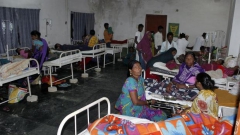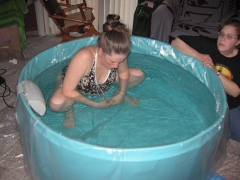04/03/2017
25 million warrior moms give birth every year in India
 In 2000, the Indian Government ratified the objectives of the Millennium for the Development of the United Nations thus committing to reduce child mortality and improve maternal health by 2015.
In 2000, the Indian Government ratified the objectives of the Millennium for the Development of the United Nations thus committing to reduce child mortality and improve maternal health by 2015.
The proposed solution for the India by Indians was: to make sure all women give birth in a hospital.
The proposed method: free care at the public hospital and reimbursement of the transportation costs. And as a side effect, discrediting the dais (traditional Indian midwives with oral and practical knowledge but no diploma) as well as midwives in the Western sense whose profession has been removed of the map – in the 1960s, the India ‘created’ the profession of ‘Auxiliary Nurse Midwives’ to be later replaced by ‘General Nurse Midwives’ (source). All that to encourage women to move away from the traditional system of giving birth at home and rather to go and see the ‘professionals’ at the hospital where treatment could be provided. In itself the idea makes sense I reckon. Yes except that (it’s upsetting, for every measure that the Indian authorities take there is a ‘but’)...
The goal was not achieved despite a huge drop in infant mortality (from 374 per 100,000 births in 2000, it decreased to 174 in 2015 compared to a target of 139). At the same time the number of deliveries at the hospital are believed to have gone up from 25 to 79% according to Unicef (source). Except that it seems that these two trends are in fact not related! But obviously the Government was tempted by the shortcut – who wouldn’t be? But no. According to Jishnu Das, an economist at the World Bank, infant and maternal mortality has fallen ‘simply’ because women are fewer children: 3.3 children per woman in 2000 (5.9 in 1960!) to 2.1 in 2015. I dont completely see the link, but he looked quite sure of himself.
On the other hand it became crazy in the hospitals. And I can testify, since I visit hospitals (public and private) for work.
In the (overcrowded) cities, public hospitals (which do not have the right to refuse patients) are overloaded, with three women sharing a bed when they are lucky enough to find one. With women often treated like shit (because they are poor and illiterate and a doctor is a bit of a God since he saves lives). Or who are slapped by the medical profession when they scream too loudly because of the pain (source). And with women who must give birth alone, because the relatives (even the mother or husband) are not allowed in the labour room.
sharing a bed when they are lucky enough to find one. With women often treated like shit (because they are poor and illiterate and a doctor is a bit of a God since he saves lives). Or who are slapped by the medical profession when they scream too loudly because of the pain (source). And with women who must give birth alone, because the relatives (even the mother or husband) are not allowed in the labour room.
And on the other hand you have understaffed doctors and nurses who have to give birth to dozens of babies at the same time (it is hard to keep your humanity and empathy when you do chain work I guess – in any case that's what thinks the President of the Association of Indian Gynaecologists: “We will first ensure care for all before talking about respect”). And sometimes these professionals get lynched by villagers if everything doesn’t go as well as planned. Literally. Like, they get stoned.
In cities and private hospitals for the richest, abuses are of a different kind, because it’s hard to insult those who sign a (big) check. Here again I can testify with my own delivery and of most of those around me. Abuse or violence takes the shape of ‘forced’ caesarean sections, unnecessary inducements, opening of the cervix by hand. Which sadly doesn’t happen only in India it seems. And then as soon as babies are born they are stuffed with formula (I mean it, they are more often than not given a dose which is three times the size of their stomach so that they sleep and let their mother rest). However preventing newborns to nurse within the first hour can have lasting and damaging consequences for breastfeeding later on.
 Of course there are also ‘good’ doctors. But apart from the fact that they are not easy to find, they are also under pressure from the hospitals which considers the patient rotation as a Key Indicator of Performance. There are also a few birth houses in the country (one in Hyderabad and one in Cochin).
Of course there are also ‘good’ doctors. But apart from the fact that they are not easy to find, they are also under pressure from the hospitals which considers the patient rotation as a Key Indicator of Performance. There are also a few birth houses in the country (one in Hyderabad and one in Cochin).
That’s why we can observe a micro-movement of affluent women who decide to give birth at home accompanied by a trained midwife (i.e. able to recognize when there is an emergency that requires a gynaecologist intervention and a hospital set-up) (source)).
Finally, in the (not overcrowded) countryside, they miss material, blood, qualified doctors, and caesareans required to save lives can not be carried out.
In short the situation is not very simple isn’t it? Not simple, and not glorious.
For the situation to improve we must tell women (all women really because even the educated and privileged ones like me are not aware) that birthing takes time and that it’s okay to not rush things. That birthing bloody hurts but it’s not what matters in the end, because it’s so much more than the pain (without being puppy sentimental), after all “we’re here to suffer” says my father as soon as we start hiking. That birthing is a natural process and that unless there are complications the mother can do everything alone; she’s stronger that she believes and she must trust her body. That episiotomy doesn't need to be systematic. And that regardless of the type of delivery, the baby should be placed on the mother's chest immediately after birth.
People must also make an effort to choose their doctor. The ‘scoring’ system certainly helps: there are websites/apps where patients note doctors and comment on the quality of care they received. This helps to make a more informed choice even though in general there are too many different comments. And when you think that almost 60% of the allopathic doctors in India would actually not have diploma (or even generally not have studied medicine at all), you freak out.
Doctors should agree to come down from their pedestals (at least most of them). Hospitals should get more of them and nurses and the medical cursus needs to be improved (a little bit of patient psychology wouldn’t hurt, but it is my personal opinion).
The idea of trained midwives with a formal curriculum and real responsibilities for non-complicated, non-risky deliveries (a bagatelle in 80% of cases) thus relieving gynaecologists and allow them to focus on problematic births should be seriously considered. That’s apparently what did Sri Lanka successfully, even spending less money than Indian in reducing mortality at birth! (source) And if "Sri Lanka can do it, so can we (India)!" Provided people acknowledge that things are not so pretty here...
08:00 Posted in Incredible India!, My stories in India | Permalink | Comments (0) | Tags: india, childbirth, birth, birthing, labour, maternal mortality, infant mortality, death, infants, c-section, ceasarians, gynec, doctors, nurses, midwives | ![]() Facebook | |
Facebook | |
03/02/2015
Baby Samourai made-in-India – 7. After the pool
Eventually they took me out of the water for good. And then, I was swimming (note the water metaphor, it's beautiful isn’t) in complete surrealism.
Imagine. I've always been the first one to say, as more than 80% of the French (2), that if I give ever birth, I will get the epidural. No question about it! With my argument: when you go to the dentist, you get an anesthesia. Well here it’s the same.
And here I was, drowning in pain, and saying nothing. Nothing at all. Not a word. I suffered in SILENCE. Just a voice in my head screaming "but just give me a fucking epidural already!"). A Samourai in all its glory!
And there, out of nowhere an anesthetist materialized, almost sorry to be there: everyone seemed to over-convinced that I wanted a natural birth (probably because I had opted for the water birth) and therefore was against painkillers. So I had to listen to the speech of my doctor who explained to me that I had no reason to be ashamed of reducing pain, that I had already gone through a lot, and that she herself had given birth to twins by caesarean. In total surrealism I was swimming, I tell you!
I refused to sniff gas and but accepted a spinal (no time for the epidural). Immediate relief!
In short, I ended up giving birth... Lying on a table, legs spread, with my favorite Indian, three gynecs, two pediatricians, an anesthetist, a midwife, and six nurses in the room. And I couldn’t care less! It actually even made me laugh thinking back of the 'intimate' childbirth I had planned!
And Baby Samourai was there! On my chest! Peeing on me! That’s how we realized it was a boy: doctors had forgotten to check...
In India, sex determination of the fetus is prohibited, since Indians took advantage of this technology to abort girls – which are expensive, with the dowry. India has a deficit of girls, and in some States it has started to cause serious problems, having to import brides and all (see these posts for more on the topic).
And the final word: baby Samourai hates baths, which should not surprise anyone... ;-)
(2) The French are apparently more sensitive than the British since only 30% of the latter opt for anesthesia (Sources: http://www.liberation.fr/vous/2011/10/18/70-d-accouchements-avec-peridurale_768628;) http://www.babycentre.co.UK/a542571/epidural)
(The End)
08:00 Posted in Expatriation (in India and in other countries), Incredible India!, Little Samourai, My stories in India | Permalink | Comments (0) | Tags: india, birth, water birth, pregnancy, baby, infant, newborn, delivery, midwife, swaddling, swaddle, diaper, breastfeeding, hospital, fertility, contraception, sterilization | ![]() Facebook | |
Facebook | |
02/28/2015
Baby Samourai made-in-India – 6. In the pool
 At 6 o'clock we set foot (and wheelchair) for the delivery room to attend the filling of the pool – apparently the sound of running water itself encourages the cervix to open up. And all of a sudden I was very far from the idea I had of water birth. Yes, curiously, despite the awful video, I still had romantic images of the thing.
At 6 o'clock we set foot (and wheelchair) for the delivery room to attend the filling of the pool – apparently the sound of running water itself encourages the cervix to open up. And all of a sudden I was very far from the idea I had of water birth. Yes, curiously, despite the awful video, I still had romantic images of the thing.
First the image of a naiad frolicking in a hot water spring, her long hair covering her bare breast (reserved, the naiad), birds joyfully chirping in the surrounding trees. And splash, a small cry, and her baby is there, swimming around her. A natural childbirth, I thought, going back to the (hot) source. Looking back, I had overlooked that most births happen night – the outing in the jungle is immediately less romantic – and that I should probably go back to prehistory to find an ancestor who had tried this method, so maybe not so ‘natural’ after all.
Another image I had, more 'modern', was of a five star bathtub, with bubbles, bath salts, scented candles, music and a glass of white wine. This vision almost made me eager to give birth!
But there, as everyone was busy setting up the whole thing and the horror of the situation was striking me in the face – I was going to have to go into this inflatable pool and suffer – I didn’t dare shout out to misunderstanding ("STOOOOP! Stop everything! I don’t want this! I and to go and lay on the table, I want the epidural!”). No, instead, I took off the horrible hospital gown and stepped into the pool. This is when the midwife offered to go pick up my sport bra. I was already in so much pain that I didn't care being in the pool with only my bra, nevermind, it was too much effort to change. She also offered to plug my MP3 but suddenly the slightest sound was painful to hear (so much for all the relaxation tracks I had downloaded!).
Once in the water, the Gynec asked me if I the pain had reduced. Apparently she was expecting a positive answer and eager to please her, I nodded. “Yes it’s always the same!”, she was happy. In fact I was in so much pain that I could only sit in a corner, immobile, hoping that it would go away if I didn’t move a muscle. After an hour, to please the midwife, I tried another position. And spent the next hour immobile in another corner, but squatting.
I must have stayed 3 hours in the water. Small breaks I was taken out to pee in a portable toilet (despite the encouragement of the medical team, I could not bring myself to piss in the pool), and other fun stuff. Finally my Gynec surrendered: there was nothing to do, my cervix refused to go faster than the music and hot water was not accelerating its opening.
(To be continued...)
08:00 Posted in Expatriation (in India and in other countries), Incredible India!, Little Samourai, My stories in India | Permalink | Comments (0) | Tags: india, birth, water birth, pregnancy, baby, infant, newborn, delivery, midwife, swaddling, swaddle, diaper, breastfeeding, hospital, fertility, contraception, sterilization | ![]() Facebook | |
Facebook | |














